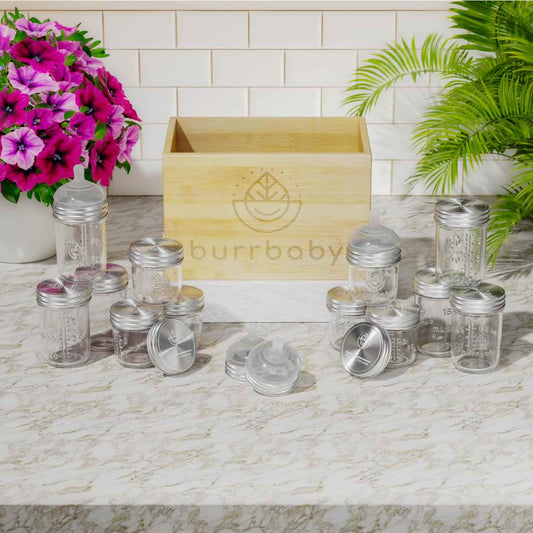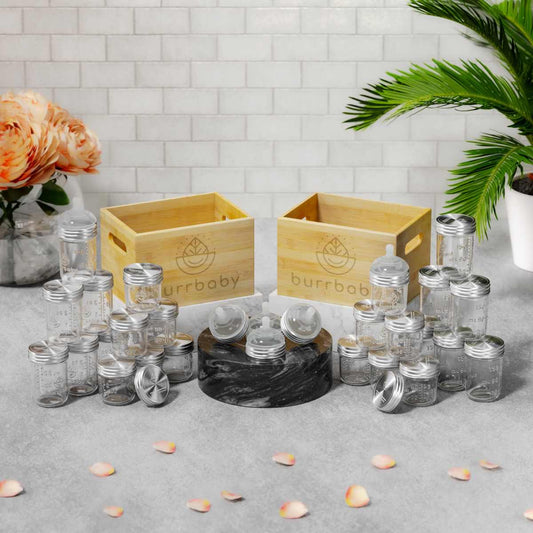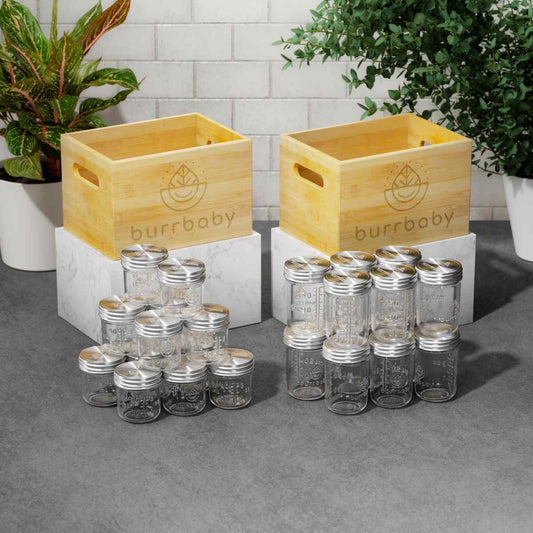Breast milk is an essential source of nourishment for your baby, providing important nutrients and antibodies that contribute to their overall health and development.
For many mothers, pumping breast milk becomes is an integral part of their breastfeeding journey, whether it’s for maintaining milk supply, providing for a premature baby, preparing to go back to work, or just any other time they might not be able to breastfeed.
Understanding the right time to start pumping can help you make informed decisions about your breastfeeding routine and ensure that you provide the best nutrition for your little one.
Article Overview:
- Stages of breast milk production
- When it’s appropriate to begin pumping
- Tips for successful pumping
- Safe storage of breast milk
At Burrbaby, we're dedicated to being a part of a healthier world for your children. We hope to accomplish this through our zero-plastic glass breast milk storage containers and bottles. These completely non-toxic, sustainable choices protect your baby's health and our planet.
This article is not medical advice and we advise mothers to consult with a lactation consultant.
Understanding Breast Milk Production
Breast milk production has several phases, each with unique characteristics and benefits. The human body is truly amazing in its ability to adapt breast milk to accommodate your baby’s specific needs in their developmental stage. This also means we need to carefully consider when breast milk is expressed and how that relates to when it should be fed to your baby.
Stages of breast milk production
Colostrum is the first milk your body produces, typically starting during the last few weeks of pregnancy and continuing for a few days after birth. This thick, yellowish substance is rich in antibodies, vitamins, and minerals, providing nutrients and immune protection for your newborn.
Between 3 and 5 days after birth, your milk transitions from colostrum to a mixture called transitional milk. It becomes less thick and more abundant, containing higher levels of fat, lactose, and calories to meet your baby’s growing needs.
Around two weeks postpartum, your milk fully transitions to mature milk. This white or slightly bluish liquid perfectly balances nutrients, proteins, fats, and carbohydrates to support your baby’s growth and development.
When to Start Pumping Breast Milk
Many new mothers have the same question: when can they start pumping breast milk? As with most topics relating to breastfeeding and pumping, the answer varies depending on your individual circumstances and needs. However, some common scenarios may influence the decision on when to begin pumping.

Pumping during the early days after birth
Preterm or medically fragile babies
In the case your baby is born prematurely or has medical issues preventing them from breastfeeding, you may need to start with manual pumping or an electric pump immediately to establish and maintain your milk supply.
Pumping during these early days can help ensure that your baby receives essential nutrients and antibodies from your breast milk, even if they cannot latch on and nurse directly.
Establishing milk supply
For some mothers, pumping early can help stimulate milk production and increase supply to aid in milk flow. If you are struggling with a low milk supply or are concerned about your baby’s weight gain, consult a lactation consultant or healthcare professional. They can advise whether early pumping is appropriate for your situation.
Pumping after the first few weeks
Returning to work or school
If you plan to return to work or school and want to continue providing breast milk for your baby, it’s a good idea to try to pump a few weeks before your return. This will give you time to establish a routine, get used to your breast pump, and build up a freezer stash for your baby.
Your milk will not “mature” until 2-3 weeks postpartum, so pay close attention to when you start pumping and when that pumped milk is fed to your baby. It's always a good idea to use up the oldest milk first.
Building a freezer stash
Some mothers need to pump extra breast milk to create a “freezer stash” for future use. It's typically best practice to start freezing breast milk for your stash once your milk supply has stabilized, usually around four to six weeks postpartum when you are through the transitional milk period. This is because the transitional milk meets needs of your baby specific to the time it is produced.
Remember to follow safe storage guidelines and use non-toxic, eco-friendly storage solutions like Burrbaby’s glass containers.
Head here to read about tips for safe breast milk storage practices.
Exclusive breast milk pumping from the start
Personal choice or medical reasons
You might exclusively pump breast milk from the start due to personal preference or medical reasons. If you do decide to pump exclusively, it’s a good idea to establish a regular pumping schedule to maintain your milk supply and meet your baby’s nutritional needs.
Try to pump around the same time every day to mimic baby's feeding so you can maintain a good milk supply. As always consult with a healthcare professional or lactation consultant to determine the best time for you to begin pumping and to get tips on pumping.
There really is no perfect time to start pumping breast milk; the answer depends on your unique circumstances. The most important factor is to ensure your baby is getting the milk it needs when your body produces it, remembering your body uses a system to provide your infant with specific nutrients at certain times.
Tips for Successful Pumping
Choosing the Right Breast Pump
To ensure a smooth pumping experience, selecting the right type of breast pump for you is essential. There are two primary types: manual or electric breast pumps. Manual breast pumps are hand-operated and often portable, making them a cost-effective and convenient option for occasional use. However, they may require more physical effort and can be quite time-consuming.
Electric pumps, on the other hand, are a more efficient and hands-free experience. They come in various designs, including single and double pumps, and often have adjustable suction levels to match your comfort.
Features to Look For In Your Breast Pump
When choosing a breast pump, consider the following to find the best fit for your needs:
- Portability: If you plan to pump at work or on the go, look for a compact, lightweight, and battery-operated pump.
- Adjustable suction: Choose a pump with customizable suction levels to ensure comfort and efficiency.
- Noise level: Look for a quiet pump, especially if you plan to pump in public spaces or while your baby is asleep.
- Easy to clean: Pick a pump with a simple design and a closed system to reduce the risk of milk contamination and simplify the cleaning process.
- Cost: The cost of a breast pump is important. Try to balance the most important features to you with a price point that is affordable. Often times, insurance will provide a pump so check with your provider.
Creating a Comfortable Pumping Environment
A relaxing and comfortable environment plays a role in your overall experience pumping. Here are some tips for creating the perfect pumping atmosphere:

Relaxation Techniques
Stress can negatively impact your milk flow and overall enjoyment—practice relaxation techniques such as deep breathing, visualization, or calming music. You can also keep a photo or video of your baby nearby to help stimulate your milk let-down reflex.
Staying Hydrated and Nourished
Your hydration and nutrition are important aspects of your routine to keep your breast milk supply up. Keep a water bottle and healthy snacks within reach while pumping to ensure you’re meeting your body’s needs. Staying well-nourished and hydrated can also help you feel more relaxed and focused during your pumping sessions.
You can read more about nutrition tips for breastfeeding moms here.
Pumping Schedule and Frequency
Another piece of the puzzle that can influence your comfort milk supply is your routine and pumping frequency. Here are some tips to help you find the perfect balance:
Mimic baby’s feeding patterns
One of the most effective ways to ensure an adequate milk supply is by mimicking your baby’s feeding patterns. Typically, newborns nurse 8 to 12 times in a 24-hour period. You can maintain a healthy milk supply and prevent engorgement by pumping as often as your baby would nurse. As your baby grows and starts to nurse less frequently, you can adjust your pumping schedule accordingly.
Prevent engorgement and maintain your supply
Engorgement is an uncomfortable fullness in your breasts that can occur when milk is not removed regularly. To avoid engorgement and maintain your milk supply, it’s recommended to pump frequently, especially during the first few weeks. Experts recommend pumping at least 8 to 10 times daily for the first month. Then, as your milk supply becomes more established, you can gradually reduce the number of daily pumping sessions - again, in line with your baby's natural feeding patterns.
Remember that every mother’s experience is unique, and it’s crucial to listen to your body and adjust your pumping schedule as needed. Don’t hesitate to consult a lactation consultant or healthcare professional if you have concerns about your milk supply or pumping routine.
Storing and Handling Pumped Breast Milk
Once you've pumped your breast milk, now what? How you pump and store breast milk is an important component of the story to ensure that your baby receives all the benefits of your liquid gold.
Safe storage guidelines:
Refrigeration and freezing
You can store milk in the refrigerator for up to 4 days at a temperature of 39°F (4°C) or lower. When freezing your milk, store it in the back of the freezer, where the temperature remains consistently cold. Frozen breast milk can last up to 6 months in a standard freezer or 12 months in a deep freezer. Always label your milk containers with the date of expression to help you keep track of the oldest milk in your stash.
Thawing and warming breast milk
When it’s time to use your frozen expressed breast milk, move it to the refrigerator for a slow thaw or place the container in a bowl of warm water for a quicker thaw. Avoid using a microwave to thaw or warm breast milk, as this can create hot spots that may burn your baby’s mouth and destroy some of the milk’s beneficial properties.
Gently swirl the milk to mix the fat that may have separated but avoid shaking the container vigorously. You don't want to create bubbles that could give your baby extra burps or gas.

Try to choose glass breast milk storage options
Although plastic breast milk storage bags are labeled as food-safe and free of certain harmful chemicals like BPA, there is always a risk that one of the current synthetic chemicals or additives in the plastic could leach into breast milk.
Additionally, microplastics can be shed from the plastic containers, especially during temperature fluctuations, such as when freezing and warming breast milk. These concerns cause many parents (us included) to consider alternatives to plastic for storing and feeding breast milk.
Read more: Breast Milk Storage Safety Tips and Signs of Spoilage
Burrbaby’s glass breast milk storage containers and bottles
Burrbaby offers a zero-plastic solution for storing and feeding breast milk. Our 4oz and 8oz glass containers come with premium stainless-steel lids with a silicone seal to keep your milk fresh and safe. In addition, the storage jars are compatible with our bottle conversion nipples to easily convert them into feeding bottles.
Burrbaby also offers an FSC-Certified bamboo box for safe storage and organization of your freezer stash. These products provide an eco-friendly, non-toxic, and sustainable option for mothers concerned about their baby’s health and the environment.
Check out the Mighty Mama Bundle, our comprehensive, zero-plastic glass breastmilk storage and glass bottle kit which provides everything you'll need for your breastfeeding journey.
Conclusion: Finding the Right Time to Start Pumping for You and Your Baby
Determining the right time to pump breast milk is a personal decision that depends on your unique circumstances. Whether it's during the early days to establish your milk supply or waiting until a few weeks postpartum to prepare for returning to work or building a freezer stash, pumping allows you to do what works best for you and your baby. Remember that your body produces specific nutrients and an amount of milk that align with stages of your baby’s growth.
Breast milk production is influenced by hormonal changes and your baby’s demand, so it’s essential to be able to pump in a way that mimics your baby’s feeding patterns. Creating a comfortable pumping environment and staying well-nourished and hydrated can also help you pump enough and enjoyable pumping experience.
Lastly, when storing and handling your precious liquid gold, consider using non-toxic and sustainable storage solutions like Burrbaby’s glass containers to protect your baby’s health and contribute to a more eco-friendly world. By following these guidelines and consulting with healthcare professionals when needed, you can make informed decisions about pumping and provide the best nourishment for your little one.
References:
Centers for Disease Control and Prevention. (2019). Proper Storage and Preparation of Breast Milk. https://www.cdc.gov/breastfeeding/recommendations/handling_breastmilk.htm
American Academy of Pediatrics. (2017). Policy Statement: Breastfeeding and the Use of Human Milk Initiatives. https://publications.aap.org/pediatrics/article/150/1/e2022057988/188347/Policy-Statement-Breastfeeding-and-the-Use-of
Le, H. H., Carlson, E. M., Chua, J. P., & Belcher, S. M. (2008). Bisphenol A is released from polycarbonate drinking bottles and mimics the neurotoxic actions of estrogen in developing cerebellar neurons. Toxicology Letters, 176(2), 149-156. https://www.ncbi.nlm.nih.gov/pmc/articles/PMC2254523/
Schettler, T. (2006). Human exposure to phthalates via consumer products. International Journal of Andrology, 29(1), 134-139. https://pubmed.ncbi.nlm.nih.gov/16466533/
Mead, M. N. (2008). Contaminants in Human Milk: Weighing the Risks against the Benefits of Breastfeeding. Environmental Health Perspectives, 116(10), A426. https://www.ncbi.nlm.nih.gov/pmc/articles/PMC2569122/
Meier P, Patel AL, Wright K, Engstrom JL. Management of breastfeeding during and after the maternity hospitalization for late preterm infants. Clin Perinatol. 2013 Dec;40(4):689-705. doi: 10.1016/j.clp.2013.07.014. https://pubmed.ncbi.nlm.nih.gov/24182956/
Odom, E. C., Li, R., Scanlon, K. S., Perrine, C. G., & Grummer-Strawn, L. (2013). Reasons for earlier than desired cessation of breastfeeding. Pediatrics, 131(3), e726-e732. https://pubmed.ncbi.nlm.nih.gov/23420922/
March of Dimes. Feeding your baby after the NICU https://www.marchofdimes.org/find-support/topics/neonatal-intensive-care-unit-nicu/feeding-your-baby-after-nicu
Mohrbacher, N. (2010). Breastfeeding answers made simple: A guide for helping mothers. Hale Publishing. https://www.amazon.com/Breastfeeding-Answers-Made-Simple-Helping/dp/0984503900
Spatz DL. Ten steps for promoting and protecting breastfeeding for vulnerable infants. J Perinat Neonatal Nurs. 2004 Oct-Dec;18(4):385-96. doi: 10.1097/00005237-200410000-00009. PMID: 15646308. https://pubmed.ncbi.nlm.nih.gov/15646308/
American Pregnancy Association. (2020). Breastfeeding Overview production. https://americanpregnancy.org/healthy-pregnancy/breastfeeding/breastfeeding-overview
Cleveland Clinic. Lactation https://my.clevelandclinic.org/health/body/22201-lactation
La Leche League International. Pumping Milk https://llli.org/breastfeeding-info/pumping-milk/
Kent JC, Ashton E, Hardwick CM, Rowan MK, Chia ES, Fairclough KA, Menon LL, Scott C, Mather-McCaw G, Navarro K, Geddes DT. Nipple Pain in Breastfeeding Mothers: Incidence, Causes and Treatments. Int J Environ Res Public Health. 2015 Sep 29;12(10):12247-63. doi: 10.3390/ijerph121012247. PMID: 26426034; PMCID: PMC4626966. https://pubmed.ncbi.nlm.nih.gov/26426034/
La Leche League International. (2016). The Womanly Art of Breastfeeding. Ballantine Books. https://www.amazon.com/Womanly-Art-Breastfeeding-Completely-Revised/dp/0345518446
Mohrbacher, N. (2010). Breastfeeding Answers Made Simple: A Guide for Helping Mothers. Hale Publishing. https://www.amazon.com/Breastfeeding-Answers-Made-Simple-Helping/dp/0984503900
Spatz DL, Edwards TM. The Use of Human Milk and Breastfeeding in the Neonatal Intensive Care Unit: Position Statement 3065. Adv Neonatal Care. 2016 Aug;16(4):254. doi: 10.1097/ANC.0000000000000313. PMID: 27391566. https://pubmed.ncbi.nlm.nih.gov/27391566/
World Health Organization. (2018). Infant and young child feeding: Model chapter for textbooks for medical students and allied health professionals. Geneva: World Health Organization. https://apps.who.int/iris/handle/10665/44117










